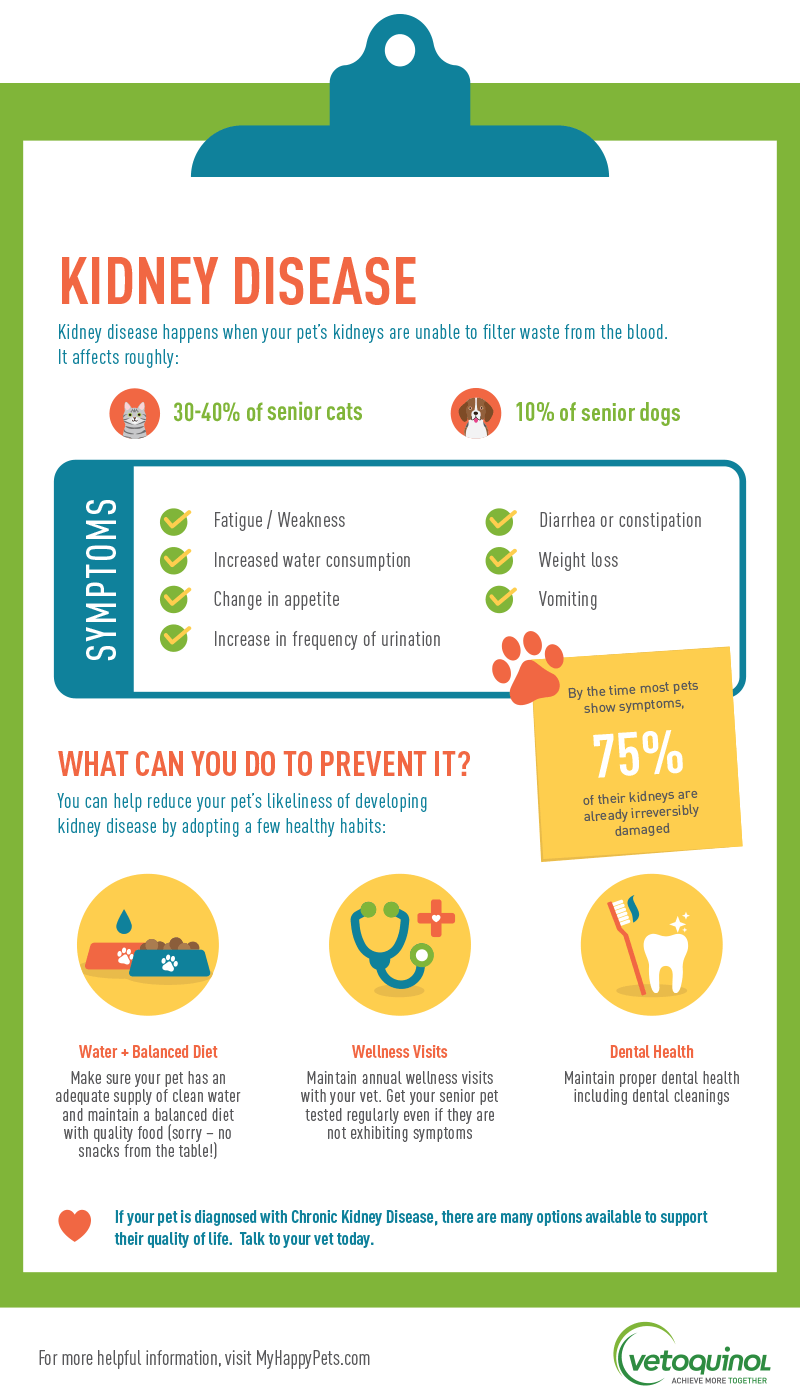Renal Digital Toolkit
We are happy to provide you with the Renal Digital Toolkit, a resource that makes it easy to maintain timely, relevant communications with pet parents. The Vetoquinol team is dedicated to helping pets and improving the clinic experience for you and your clients. This digital toolkit is just one of the ways we use our passion for animal health to help you grow your business.
Below, we have provided information you can simply copy and paste into social media posts, on your website, and in emails and letters to your clients. Feel free to use the information as provided or personalize to your taste. The Renal Digital Toolkit includes the following:
-
-
- 12 social media posts for use on sites such as Facebook, Twitter and Instagram
- 2 articles for use on your website or in newsletters
- “Kidney Disease” infographic
-
We hope you find this toolkit to be a valuable resource for your practice. Please feel free to contact your Vetoquinol USA Sales Representative with any questions.
Articles
Use the content below on your website, blog, or in your newsletter.
Importance of Routine Veterinary Care for Older Pets
 Our pets are family to us and we want to give them the best. Providing routine care is one way we show our love. As they age, it can be difficult to recognize what our pets need. It becomes even more important to pay close attention to changes in their habits and maintain regular visits with your veterinarian.
Our pets are family to us and we want to give them the best. Providing routine care is one way we show our love. As they age, it can be difficult to recognize what our pets need. It becomes even more important to pay close attention to changes in their habits and maintain regular visits with your veterinarian.
When is your pet a senior pet? Cats and small breed dogs are considered senior at 7 years of age while large breed dogs are typically considered senior at 6 years of age.
For pets that have not yet reached senior status, it is recommended to have yearly exams. Along with the annual exam, your veterinarian will recommend routine vaccines, internal parasite control, heartworm prevention and flea/tick control. Other preventatives may be offered based on your regional location.
Once your pet becomes a senior, routine exams should occur every six months. Diagnostics such as bloodwork and urinalysis will likely be added to the exam. Based on those findings, further tests may be recommended to investigate any findings of concern. If there are specific problems, more frequent rechecks and diagnostics may be recommended to keep your pet as healthy as possible.
Your veterinarian will most likely discuss common problems in senior pets:
- Osteoarthritis
- Chronic Kidney Disease
- Liver disease
- Behavior problems
- Heart disease
- Thyroid disease (hypothyroidism in dogs and hyperthyroidism in cats)
- Dental disease
- Diabetes
- Other endocrine diseases
- Weight control
It is important to have annual (or bi-annual) routine exams, blood-work and urinalysis to maintain your senior pet’s health. By following your veterinarian’s recommendations, you may catch problems before they progress and keep your senior pet in tip-top shape.
How Do I Know If My Cat or Dog Has Chronic Kidney Disease?
 The kidneys play an important role in many normal body processes. Normal kidney function involves the following:
The kidneys play an important role in many normal body processes. Normal kidney function involves the following:
- Filtering wastes from the blood and excreting them in the urine
- Balancing body salts, acid and water
- Maintaining normal red blood cell production
- Maintaining proper blood pressure
- Balancing calcium, phosphorus, and potassium
Chronic kidney disease (CKD) is a disease that affects both cats and dogs, though diagnosed more frequently in cats. It becomes more common as pets age. CKD is a progressive disease which causes the loss of kidney function over time. There are many causes of CKD. Regardless of cause, the disease often results in non-specific clinical signs.
How do you tell if your cat or dog has chronic kidney disease? This can sometimes be difficult as clinical signs appear late in the course of the disease and may not be obvious. One of the first things you may notice is that your dog or cat is more tired than normal. They may urinate and drink excessively. They may not eat all of their meal or stop eating completely. Other common clinical signs include vomiting, diarrhea, weight loss, dehydration and bad breath. If any of these signs occur with your pet, it is important to schedule an appointment with your veterinarian to have your pet evaluated.
What will happen at the veterinary clinic? Your veterinarian or veterinary nurse will collect a history on your pet. Be prepared to offer information as to when clinical signs first appeared, what your pet is doing at home, and how he or she is feeling. After collecting all the pertinent information, a physical exam will be performed which typically includes taking the temperature, heart rate, and respiratory rate of your pet and evaluating the skin, eyes, mouth, ears, hair, palpation of the abdomen (which can allow evaluation of the size of the kidneys), limb manipulation, and pain evaluation. After this, your veterinarian may recommend a minimum database be performed which includes a blood draw for a complete blood count (CBC) and serum chemistry and urine collection for a urinalysis.
- Complete Blood Count evaluates red blood cells and white blood cells specifically looking for anemia (low red blood cell count) and any signs of infection or inflammation (increased white blood cells).
- Serum Chemistry evaluates many components in the blood including those that are filtered by the kidneys, like blood urea nitrogen (BUN) and creatinine (Cr). Elevations in these values don’t occur until 75% of the kidney function is lost and, in conjunction with other abnormalities, can lead to the diagnosis of CKD. In addition, the serum chemistry evaluates electrolytes and other substances that may be altered with CKD.
- Urinalysis evaluates the kidneys’ ability or inability to concentrate urine and indicate urine infections and stones. Assessing the protein levels in the urine can also help add valuable information about the underlying condition.
In addition to a minimum database, your veterinarian may recommend more specific or clarifying procedures:
- Urine culture evaluates which bacteria are causing an infection and which antibiotics will be effective against the bacteria in the urine.
- Urine protein/creatinine ratio elevations can indicate specific dysfunction within the kidneys.
- Blood pressure increases are typically seen with CKD and it is important to control persistently elevated blood pressure.
- Radiographs evaluate kidney and bladder shape and size and may show evidence of certain types of stones in the urinary tract.
- Ultrasound offers a more detailed evaluation of kidney and urinary tract structures.
- Kidney biopsy can provide more information as to the cause of CKD though is not typically performed until after the diagnosis of CKD has been made.
Recently, a blood test was introduced called Symmetric Dimethyl Arginine (SDMA). The test detects 40% loss of renal function versus the typical 75% loss indicated by elevations in BUN and Creatinine. With the introduction of this test, kidney impairment can be detected earlier and interventions can be implemented to slow progression of the disease.
CKD is a common occurrence in cats and dogs. Knowing what to look for is the first step in properly identifying CKD in your pet. Identification of any of the clinical signs warrants an appointment with your veterinarian to evaluate for CKD. The earlier the diagnosis, the sooner treatment can begin, which can prolong the life of your pet.


Social Media Posts
Copy and paste the desired text to your clinic’s Facebook, Twitter or Instagram pages and follow any additional steps as instructed. Right-click the associated image and choose “Save Image As…” to save the image to your computer, then add the image to your post.